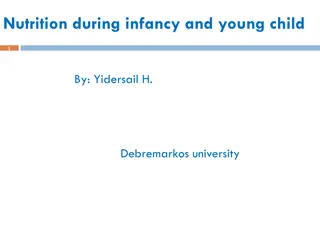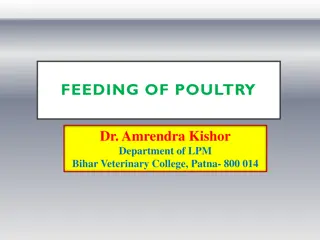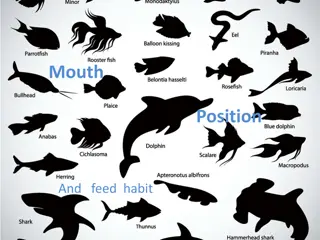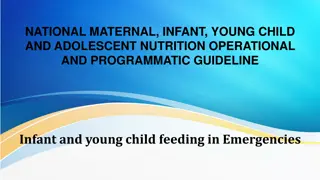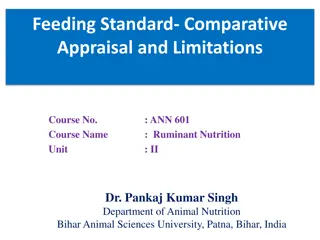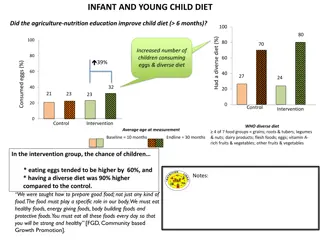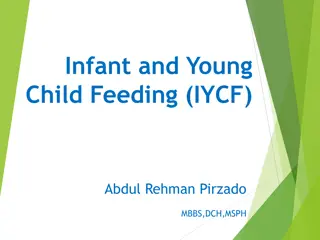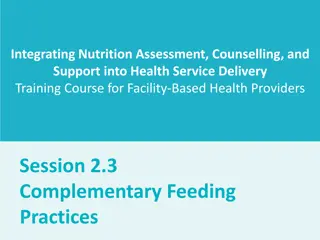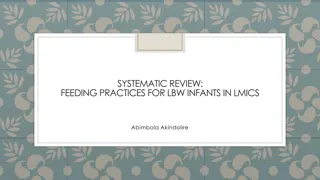Guidelines for Infant Nutrition - Diet and Feeding Recommendations
Providing comprehensive information on the diet and feeding recommendations for infants, this guide covers the importance of human milk, introduction of complementary foods, the role of water in the diet, and factors to consider regarding juice intake. It emphasizes the gradual introduction of new foods, monitoring for potential allergies, and promoting a nutritious diet for optimal infant health.
Download Presentation

Please find below an Image/Link to download the presentation.
The content on the website is provided AS IS for your information and personal use only. It may not be sold, licensed, or shared on other websites without obtaining consent from the author.If you encounter any issues during the download, it is possible that the publisher has removed the file from their server.
You are allowed to download the files provided on this website for personal or commercial use, subject to the condition that they are used lawfully. All files are the property of their respective owners.
The content on the website is provided AS IS for your information and personal use only. It may not be sold, licensed, or shared on other websites without obtaining consent from the author.
E N D
Presentation Transcript
Diet of the normal child dr. Roshanak Kadivar *****
Human milk Academy of pediatrics recommends human milk as the source of nutrition for the first 6 months of life, with continued intake for the first year and as long as desired thereafter.
Complementary foods By approximately 6 months, complementary feeding of semisolid foods is suggested. By this age, infants need additional sources of several nutrients, including protein, zinc, and iron. Cereals are commonly introduced around 6 months of age. They can mixed with breast milk, formula, or water and later with fruits. Single-grain iron-fortified cereals ( rice, oatmeal, barely) are recommended as starting cereal to help identify possible allergy or food intolerance.
Water !!! Healthy infants do not need extra water Breast milk and formula, provide all the fluid needed. By starting solid foods, water can be added to the diet. During the 4-6 months of age, starting actively to separate mealtime from bed time is recommended. Once the infant learns to eat solid cereals, parents should introduce one food at a time, and they should wait 2-3 days before introducing a new one and watch for signs of an allergic reaction such as diarrhea, rash, or vomiting. In general meats and vegetables have more nutrients per serving than fruits and cereals.
Infants do not need juice !! If juice is given, it should be started only after 12 months of age. Give in a cup instead of bottle. Limited to 4 oz (1-3 y) daily of 100% natural . Only with meals or snacks. If these recommendation are not followed, the infant may have reduced appetite for other more nutrition's food. Too much juice may cause diaper rash, diarrhea, and weight gain.an infant should never be put to sleep with a bottle of milk, formula, or juice due to early childhood caries. For the first 2 months it is important to set the stage for making a distinction between sleeping and feeding time.
Notes about diet Green vegetables bring nutrients, vitamins, minerals, and micronutrients. The avoidance of foods with high allergic potential in infancy ( fish, tree nuts, peanut, dairy products and eggs ) is no longer supported. Early introduction may actually help to prevent food allergies. Once the child can sit and bring her hands or other objects to the mouth, parents may provide finger food to help the infant learn to feed themselves. To avoid choking, make sure that anything given to the infant is easy to swallow, soft, and cut in very small pieces.
Parents should know Initially the infant should be eating approximately 4 oz of solids at each daily meal. If the food is prepared by the adult, it should be prepared without preservatives or high salt. All foods with the potential to obstruct the young infant's main airway should be avoided in general until 4 y. Honey ( risk of botulism) should not be given before 1 y. If the introduction of solid foods is delayed, nutritional deficiencies can develop, and oral sensory issues may occur.
When---self feeding General signs of readiness include the ability to hold the head up, big enough (2 BW), opening their mouths wide showing eager anticipation of eating food and interest in foods, sitting unassisted, bringing objects to the mouth, the ability to track a spoon and take food from the spoon, and stopping when they are full. Exposure to different textures and the process of self-feeding are important neurodevelopmental experiences for infants.
General recommendation A child should eat 3 meals a day and 2 healthy snacks. A general offer : 1 table spoon per age of each food provided by meal, with more given if the child requests. Children should not be eating more than an adult palm per serving. The plate image is divided into 5 sections: Fruits, grains, vegetables, protein and dairy.
Other suggestion Switch to fat-free or low fat (1%) milk after 2 y. After 2 y, it is recommended that fat intake gradually be reduced to approximately 30% and not less than 20% of calories. Replace proteins from red meat with a mix of fish, chicken ,nuts, and legumes. Children younger than 2 y should not have any added sugars in their diet. Between 2-18 y should get no more than 25 gr each day. Recommended salt intake for children varies from 1900-2300 mg per day, depending on age. Toddler with excessive milk intake (more than 32 oz) are at risk for iron deficiency.


![READ [PDF] Dash diet Cookbook for beginners: 365 days of simple, healthy, low-s](/thumb/2057/read-pdf-dash-diet-cookbook-for-beginners-365-days-of-simple-healthy-low-s.jpg)

